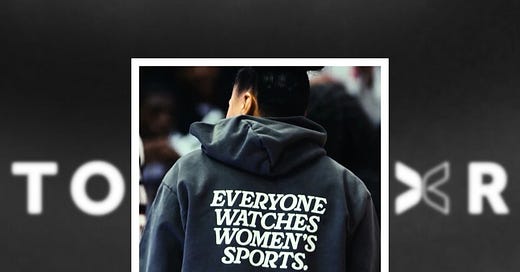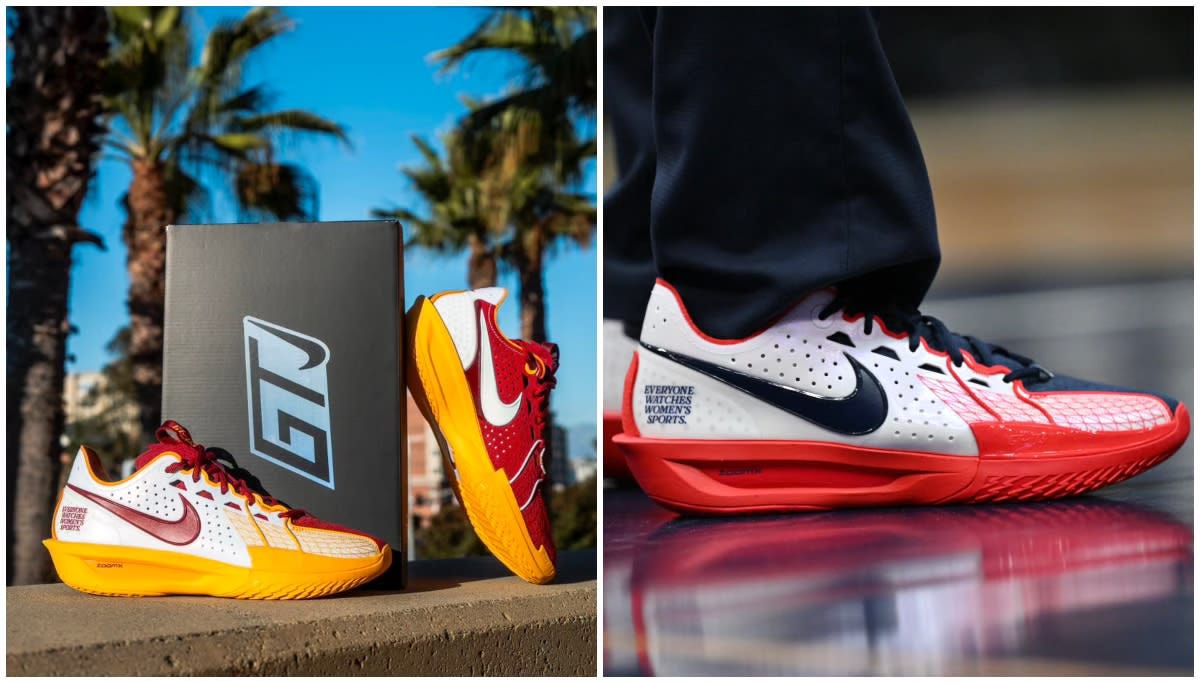“Because You’re Worth It”
“You’re in Good Hands”
“Just Do It.”
Are these brands? No, of course not. They’re brand slogans. Or taglines, if you care to distinguish.1 They operate in service of a bigger entity— a brand— to deliver a shortcut to a consistent and motivating idea about that entity. On their own, they do not offer unique benefits. They’re not accountable to a specific set of consumer expectations. They’re assets.
But what if they did begin to hold space for their own meaning, expectations, and benefits and become a brand or sub-brand in their own right? Is this perhaps an untapped avenue of growth for businesses? Maybe… maybe more so today than ever.
The slogan “Everyone Watches Women’s Sports™” from Togethxr— a women’s sports media and commerce company started by Sue Bird, Chloe Kim, Simone Manuel, and Alex Morgan— could be the marketing world’s first test case of this opportunity. Togethxr premiered this statement in December 2023 (after a series of other ‘meh’ slogan attempts) as a clap-back to supposed Twitter trolls and people in general who say, “Nobody watches women’s sports.” At first, the company put the phrase on t-shirts and hoodies in what appeared to be a simple merch drop. Those items sold like hotcakes fueled, in part, by Dawn Staley’s choice of gameday garb. By March 2024, Togethxr was launching an “EWWS™” tote bag and new colorways of the original tee. In April 2024, they filed to have the phrase trademarked. And, by the summer of 2024, anything bearing the authentic “Everyone Watches Women’s Sports” logo (not to be confused with off-font Etsy imposters) was a virally hot and hard-to-get item.
But we all know a “™” and some t-shirts do not make a brand.
What makes a brand is expectations. If the job of a brand asset is to deliver a shortcut to a consistent and motivating idea, then the job of a brand is to live up to that idea. Brands deliver a consistent set of benefits (emotional or functional) that people come to rely on to fulfill a specific need. I started to consider “Everyone Watches Women’s Sports™” as a possible brand— or rather, sub-brand— when it began to deliver and get credit for benefits distinct from its parent, Togethxr.
For starters, EWWS™ products have badge value. Celebs gave them their fame, and now they’re the literal and figurative ‘statement pieces’ of sporty fashion girls. For the wearer, they seem to fulfill a distinct activist-driven need more than any of the company’s non-EWWS™ branded stuff (apparel and media). This isn’t a knock on Togethxr’s other projects, just an assertion that they do something different for consumers than the EWWS™ line. “Togethxr”-branded media answers the need for equal attention and respect. EWWS™ answers a need to stand out.
Aside from badge value, EWWS™ goods also uniquely deliver and get credit for certain functional benefits— quality, material, and fit— that distinguish them from being ‘just another merch drop.’
Of the close to 700 reviews on the EWWS™ Tee page, the majority reference the product’s exceptional quality… actually more than mention the “Everyone Watches Women’s Sports” message. These reviews read like praise you’d expect to find on respected, apparel-driven brand sites (think Champion or Lululemon). Turns out this achievement is not far from the founders’ original goal. Jessica Robertson, Co-Founder and Chief Content Officer of Togethxr, told SportsPro at the time of the company’s inception,
“We’re being mindful about that [our e-commerce] line of revenue and what consumer products in general looks like for us as we grow… You’ll see us probably get more strategic there and look at sectors outside of just merch drops to see where we can build a more impactful business.”
It’s also been said over and over by the founders that they want their commerce line to be premium, unisex, and “fill a very big white space in consumer products for women’s sports fans.” Sounds like ‘new brand’ ambitions if you ask me.
And maybe that’s exactly what’s happening. Recently, Togethxr announced that the “EWWS™ business is the company’s fastest-growing revenue stream,” and renamed its full apparel line “EWWS™” on its website. Back in December, the company teased a shoe collab with Nike in which only the “EWWS™” logo (minus “Togethxr”) would appear on product (fans are still awaiting a full-scale launch.) It might be a stretch to say “EWWS™” is the next Air Jordan for Nike, but it certainly has this potential for Togethxr— a generative pillar that halos back to the parent brand and has the growth potential of a stand-alone identity, unique benefits, and a slightly different (bigger) audience. Not a bad model.
But, why do this? Well, we live in some interesting branding times these days. As the modes and methods for brand marketing proliferate— from creating FAST content and channels to launching on Substack— people seem to be growing even more skeptical of overtly branded content and want to protect certain spaces from the invasion of ‘big brand’ marketers— those that are solely performance-driven, out to make a buck and capture share at every possible moment.
It’s as if people learned their lesson about “letting marketers in” with the literal social demise of social media. They don’t want the same thing to happen with newer, more content-for-content-sake and content-for-connection-sake platforms. This statement from fired-up Substack writer Amanda K. Gordon in response to Rachel Karten’s post “Here Come The Brands” pretty much says it all,
“Substack 👏 is not 👏 an email marketing tool, 👏it’s a community tool.”
At the same time, these newer content platforms are pretty tempting to marketers— they’re 1) potential profit centers and 2) full of focused eyeballs looking to be informed, entertained, and convinced of something. As a marketer, it’s hard to stay away. FOMO is nipping at their heels!
A slogan or tagline-led entity presents an interesting opportunity for brands in some of these newer, content-led spaces. It’s effectively doing the opposite of what’s underway with Togethxr and its EWWS™ line, but for the same purpose. Togethxr started as a content brand and has benefitted from creating a stand-alone EWWS™ consumer products line that can grow and stretch on a separate playing field (different rules, different spectators). A consumer product-led brand could effectively do the same, but in reverse— use a slogan or tagline to represent a dedicated content platform. The two entities would exist under the same umbrella (share an aura) like most master brands and sub-brands do and better meet the needs and expectations of consumers in today’s expansive yet bespoke spaces and places.
Imagine if Glossier launched a Substack publication named “You Look Good” (their slogan) vs. “Glossier.” I think it’s fair to say the soft separation would allow for a broader array of content, perhaps better content (more trustworthy, less promotional), and, as a result, would attract new and different people into the company’s orbit. That’s growth.
The same could be said of Chick-fil-A’s recent foray into programming and online games. Their brand-slathered Chick-fil-A Play app has been criticized for being poorly executed brand indoctrination. “Eat More Chikin” (their slogan) would certainly be a weird and quirky revision of this platform, but isn’t that the vibe of the streaming entertainment marketplace they're trying to penetrate (hello— Candy Crush!)? And isn’t this identity potentially more inviting, clever and intriguing to current brand outsiders than something that bills as ‘just another brand app’?
Bottom line: if the goal is growth, then brands need to start using all of the tools in their toolbox to meet the needs and expectations of people in their growth spaces. Now is not the time to rest on one’s laurels.
Main takeaways:
Your slogan can do more than just support your brand; it could actually be a brand or sub-brand.
Today’s new communication spaces and places require new clothes, new conversation, and a different approach. Come on, marketers, read the room.
Go big— yes! AND take advantage of all the tools in your toolbox, not just the one on top.
Some marketers consider slogans campaign-specific, while taglines are ‘for all time.’ I’m not sure it matters.









